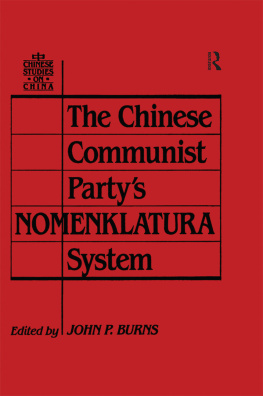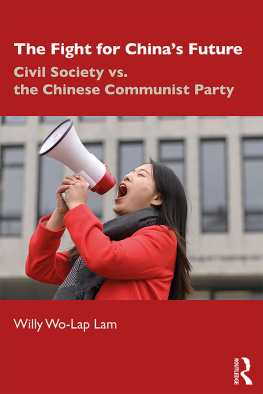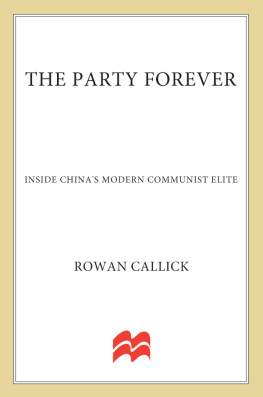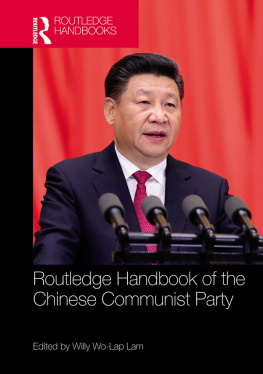The Chinese Communist Party's NOMENKLATURA System

CHINESE
STUDIES
ON
CHINA
THE CHINESE COMMUNIST PARTY'S NOMENKLATURA SYSTEM
Edited by John P. Burns
THE ASIATIC MODE OF PRODUCTION IN CHINA
Edited by Timothy Brook
BASIC PRINCIPLES OF CIVIL LAW
Edited by William C. Jones
The Chinese Communist Party's Nomenklatura System
A Documentary Study of Party Control of Leadership Selection, 1979-1984
Edited By John P. Burns
First published 1989 by M. E. Sharpe, Inc
Published 2019 by Routledge
2 Park Square, Milton Park, Abingdon, Oxon OX14 4RN
52 Vanderbilt Avenue, New York, NY 10017
Routledge is an imprint of the Taylor & Francis Group, an informa business
Copyright 1989 Taylor & Francis.
All rights reserved. No part of this book may be reprinted or reproduced or utilised in any form or by any electronic, mechanical, or other means, now known or hereafter invented, including photocopying and recording, or in any information storage or retrieval system, without permission in writing from the publishers.
Notice:
Product or corporate names may be trademarks or registered trademarks, and are used only for identification and explanation without intent to infringe.
The introduction to this book is an expanded and updated version of an article which originally appeared in Problems of Communism Vol. 36, No. 5 (SeptemberOctober, 1987). Translations of documents Nos. 110 and 1318 were originally published in Chinese Law and Government Vol. 20, No. 4 (Winter 198788).
Design by Sonja Godfried.
Library of Congress Cataloging-in-Publication Data
The Chinese Communist Partys Nomenklatura system.
(Chinese studies on China)
1. Chung-kuo chan tangOfficials and employees
Titles. I. Burns, John P. II. Series.
JQ1519.A5C4773 1989 324.251'075 88-35577
ISBN 0-87332-543-5
ISBN 13: 978-0-87332-543-1 (hbk)
Contents
Guide
Introduction
The Chinese Nomenklatura System
Reformist Communist Party leaders in both China and the Soviet Union have announced plans to trim the scope of party control over government, the economy, and mass organizations. In November 1987, for example, Chinese Party Secretary General Zhao Ziyang proposed to the Thirteenth Party Congress that a new civil service system be installed in government organs, and that economic enterprises and mass organizations themselves choose their own leaders. Party leaders have taken these steps to permit basic economic reforms within their own countries.
Perhaps the major instrument of Communist Party control of contemporary China's political, economic, social, and cultural institutions is the nomenklatura authorities ensure that leading institutions throughout the country will exercise only the autonomy granted to them by the party.
China's nomenklatura system has evolved to suit the needs of party leaders to control the state, develop the economy, and ensure that party policies are carried out throughout society. During the early 1950s, early 1960s, and early 1980s, authorities centralized control over personnel selection in Beijing largely for political reasons. During intervening years, but especially in 1957 and since 1984, the party has decentralized nomenklatura control to further its economic development plans. Whether the power to make personnel appointments was held centrally or locally, however, the party has kept it firmly under its control. Recent proposals for reform of the nomenklatura in China leave the system intact, but further restrict the scope of party authority over leadership selection.
Background
Organizations in China exist in a complex hierarchy of ranks. The state bureaucracy, for example, is organized territorially. Below the central government in Beijing are 22 provinces, 5 autonomous regions, and 3 centrally administered cities (Beijing, Shanghai, and Tianjin), all of equal rank. At the next lower level are 175 prefectures or prefecture-level units, and below them are more than 2,000 counties or county-level units. A hierarchy of party committees, extending from the Central Committee in Beijing to provincial, prefectural, and county party committees, parallels this structure.
In 1949, to strengthen Beijing's control over provincial governments, authorities set up six regional administrations that covered Northeast China (Shenyang), North China (Beijing), East China (Shanghai), South-Central China (Wuhan), Southwest China (Chongqing), and Northwest China (Xi'an).
According to the Chinese administrative hierarchy, ministers and deputy ministers of central ministries in Beijing are of equal rank to governors and deputy governors of provinces. Heads of general bureaus ( zongju ) at the center are equivalent to heads of provincial-level commissions, and heads of bureaus ( ju and si ) of central ministries and commissions are of equal rank to heads of provincial bureaus ( ting and ju ) and to heads of prefectures.China's nomenklatura system operates within this hierarchy of authority.
The political and economic priorities of party leaders have been reflected in the development of China's nomenklatura system. First, the leaders' policy of social and economic revolution required that the scope of nomenklatura control be very wide. Thus, by March 1951, senior party leaders had decided that the party must control the appointment, dismissal, and transfer of both party and nonparty cadres.
Changing economic development priorities also influenced party nomenklatura work. During periods of rapid industrialization, for example, the party sought to refine its control of industrial cadres.
A brief outline of the evolution of the nomenklatura system illustrates its sensitivity to the political needs of party leaders. By December 1950, the Central Committee's Organization Department produced the first formal lists of cadre positions to be managed by the Central Committee and by local party committees. From its inception, then, cadre management was comprehensive and shared among party units at different levels.
In April 1953 these arrangements were codified in the Organization Department's "Notice on Procedures for Government Cadre Appointments and Removals." The Organization Department requested provincial officials to submit applications for the appointment of cadres on the Central Committee's nomenklatura to the relevant central bureau for transmission to the Central Committee.
By 1953, however, the costs to the party in Beijing of relying on the central bureaus to centralize power were obvious. They had become virtually ungovernable "independent kingdoms" in China's Northeast and East-Central regions. Perhaps reflecting this concern, the 1953 Notice reveals that the central bureaus did not, at least by that time, have exclusive control over their own nomenklatura. Alarmed by the activities of Gao Gang and Rao Shushi, Beijing apparently insisted that positions managed by the central bureaus also be approved by the Central Committee. Thus, the 1953 Notice states: "Provincial party committees should submit applications for appointment of cadres managed by a central bureau to the central bureau, and then wait for the approval of the central bureau and the Central Committee before notifying the personnel department of the relevant people's government to make the appointment or removal."













